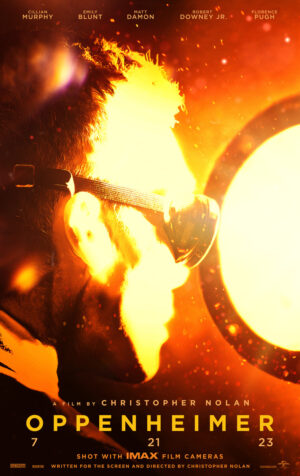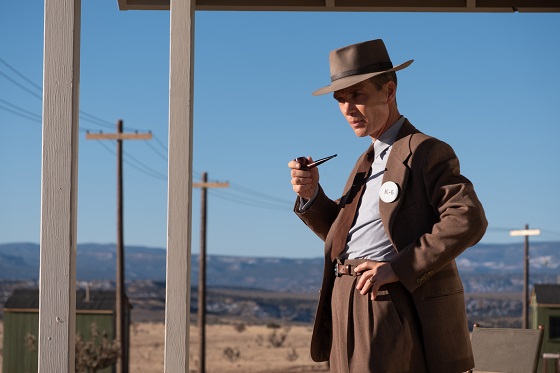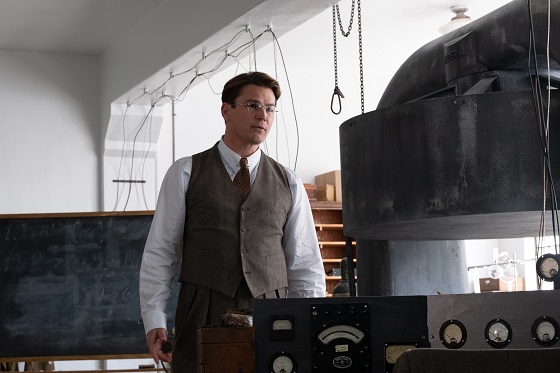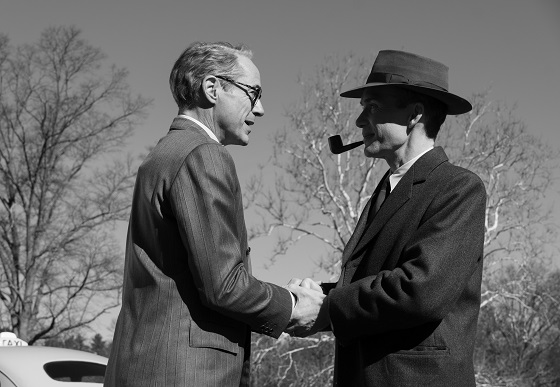

[Rating: Solid Rock Fist Up]
Christopher Nolan’s latest mega epic Oppenheimer explodes (everyone’s doing it, don’t look at me like that) on the big screen this weekend with an enormous all-star cast, an IMAX experience, and a three-hour run time. It’s an astonishing undertaking and the final product is everything a Nolan film promises. His vision has always been grand, and it’s a treat to explore and experience the magnitude of scope when his movies hit the screen.
Before we start, I must acknowledge something that affected my experience of this movie. The critics’ screening (written with my pinkie sticking out) I attended was a disaster. Hosted by AMC, the movie began and ran without sound for at least the first ten minutes, and was not restarted. If you are a Nolan fan (AND I AM), you know how heartbreaking this is. Imagine seeing the first 10 minutes of Memento without audio and trying to catch up. Or Inception. About two hours after that traumatic experience, the lights came up and the film shut off, but did start again at the same spot. Additionally, the person next to me went “hmm” after nearly every line of dialogue, so I was approaching homicidal by the end of three hours.
Now let’s begin. Christopher Nolan has always been a bit pretentious – and its always been one of my favorite things about his movies (for I am also a bit pretentious). His talent is undeniable, his skill is formidable, his vision so ambitious it’s hard to find an equal in another director. Oppenheimer, about the father of the atomic bomb as played by Cillian Murphy, has all the features of an excellent Nolan movie, but perhaps too much of them.

After five supporting roles with Nolan at the helm, Murphy finally gets the lead and he’s magnificent. J. Robert Oppenheimer was a brilliant man whose enthusiasm for progress left scars on the earth and the collective psyche of the human race. A man like that is not simple, and Murphy is expressive and guarded, brilliant and obtuse. His refusal to look at intentions before it’s too late is put squarely on display with unexpected vulnerability. Murphy handles those nuances with deftness and sensitivity, and commits to the emotional toll. Unfortunately, he does it with a voice that sounds like whispering Orson Welles, but given the movie’s rigid adherence to accurate accents, it’s forgivable.
The cast is beyond robust, it’s a parade of recognizable faces – so many stars! While Emily Blunt, Robert Downey Jr. and Matt Damon get top billing with Murphy, the cast feels more like a parade of cameos. Who is that? Is it Casey Affleck? Is it Gary Oldman? Is it Josh Peck? Is Josh Hartnett turning into Josh Brolin? The answer is yes on all counts. Rami Malek is the best handled of these, while most just feel distracting. Why is Jack Quaid there?

Per usual in a Nolan movie, the men are obsessed and compensate with achievement while the women are depressed and compensate with sultriness. Emily Blunt is Oppenheimer’s miserable, alcoholic wife, while Florence Pugh brings the tits and tragedy. Blunt stews in her anger, and it’s one of the best performances in the movie as she embodies impotent outrage over complacency.
The script is challenging, but the plot is convoluted because the truth is convoluted – and Nolan is rigid about historical accuracy here, sometimes without necessity. There are scenes that could’ve been a line of dialogue elsewhere. The three hour run time moves faster than it has any right to thanks to rapid fire, Aaron Sorkin levels of dialogue and very short scenes.
The first nearly two hours of the movie are of meetings, conferences, lectures – this movie is a lot of white men talking in chairs, and I am genuinely stumped as to why it was shot in IMAX, beyond Nolan’s preference for it and getting to play with a brand new type of film (Kodak developed the first ever black and white IMAX film stock just for him). Nolan’s previous releases made sense on the medium – as action movies. There are gorgeous landscape shots and beautiful cinematography from Hoyte Van Hoytema (Nope, Interstellar, Dunkirk). But the majority of Oppenheimer is close ups of faces and hats.

Just before the two hour mark, it gets very, very interesting – with beautiful, heartbreaking shots of achievement – all done without CGI. But these visual marvels are a small part of the movie. They do little to convey the true destruction of the bomb. The long term effects of the decision to bomb Japan are communicated through dialogue, not image. Without visual context, the actors, and Murphy in particular, have to convey the horrors the bomb dropped on the world through emotional responses to it. It’s a respectful choice that keeps the focus on the narrative of Oppenheimer’s experience, and doesn’t trot out carnage or tell someone else’s story.
Clearly, I have complaints. It’s too long. There’s too many people. The pace is dizzying (which is actually the nicest thing I can say about a three hour movie). But here’s the thing about Christopher Nolan movies – the worst one is still a goddamn Christopher Nolan movie. The technical aspects are gorgeous, everything is intentional, and the narrative is elevated – but accessible. The worst Nolan movie is still going to be one of the best movies of the year because of quality alone.

At what point does artistic vision and creative integrity need to be tempered to accommodate the audience experience? At about two hours and three minutes. But who would want Nolan to temper it? We already have Spielberg. Nolan’s obsessive commitment to detail is what makes his movies so mentally stimulating, even when he’s less dependent on visual dazzle to tell the story.
Ultimately, Oppenheimer poses the question, “just because you can, does it mean you should?” while also very clearly pointing out that some ethical dilemmas are in fact very black and white. Nolan uses his film to show that there aren’t shades of color around morality and ethics concerning human life and mass destruction, which is a pretty impressive thing to accomplish in three hours.




Comments on this entry are closed.